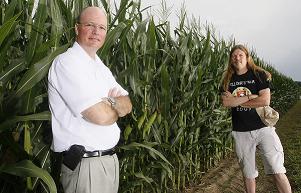 |
|
A biosensor utilizing black platinum and carbon nanotubes developed at Purdue University will help give scientists a better understanding of how the plant hormone auxin regulates root growth and seedling establishment. |
Marshall Porterfield, an associate professor of agricultural and biological engineering and biomedical engineering at Purdue University, has created a new sensor to detect the movement of auxin along a plant’s root surface in real time without damaging the plants.
The nanomaterials at the sensor’s tip react with auxin and create an electrical signal that can be measured to determine the auxin concentration at a single point. The sensor oscillates, taking concentration readings at different points around a plant root. An algorithm then determines whether auxin is being released or taken in by surrounding cells.
“It is the equilibrium and transport dynamics that are important with auxin,” says Porterfield, whose findings were published in the early online version of The Plant Journal.
…
Add new comment